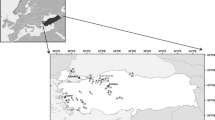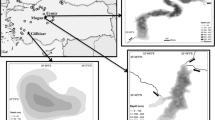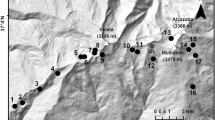Abstract
Intra-lake variation of fossil Cladocera (Crustacea) assemblages in 31 surface sediment samples in Lake Pieni-Kauro and River Saavanjoki, eastern Finland, was examined with an objective to identify habitat specificity of Cladocera in relation to local hydrology-related environmental factors. The surface sediment assemblages showed high levels of heterogeneity, mainly as to water depth and lentic–lotic gradients in the lake–river complex. This was evident from the principal component analysis which indicated a major trend from shallow to deep samples and a secondary trend from lentic to lotic samples, and from redundancy analysis (RDA), which recognized water depth and river flow as the most important environmental variables in explaining cladoceran variability within the dataset. According to the RDA and generalized linear models, Daphnia spp., Bosmina (Eubosmina), and Alona quadrangularis showed association with deep water localities, whereas Bosmina longirostris and Alona affinis preferred littoral habitats. Acroperus harpae and Chydorus sphaericus s.l. appeared to favor lotic habitats. The results propose that littoral taxa are primarily deposited postmortem or after molting close to their shallow water habitats, while planktonic cladocerans accumulate principally in deepwater locations. Accordingly, it appears that in heterogeneous basins intra-lake surface sediment samples integrate locally living fauna that is driven by local hydrology-related factors, such as water depth, sediment properties, macrophytes, and river flow and coupling biotic interactions.





Similar content being viewed by others
References
Amsinck, S. L., E. Jeppesen & F. Landkildehus, 2005. Relationship between environmental variables and zooplankton subfossils in the surface sediments of 36 shallow coastal brackish lakes with special emphasis on the role of fish. Journal of Paleolimnology 33: 39–51.
Amsinck, S. L., A. Strzelczak, R. Bjerring, F. Landkildehus, T. L. Lauridsen, K. Christofferssen & E. Jeppesen, 2006. Lake depth rather than planktovorory determines cladoceran community structure in Faroese lakes—evidence from contemporary data and sediments. Freshwater Biology 51: 2124–2142.
Anderson, N. J., 1990. Variability of diatom concentrations and accumulation rates in sediments of a small lake basin. Limnology and Oceanography 35: 497–508.
Beklioglu, M. & E. Jeppesen, 1999. Behavioural response of plant-associated Eurycercus lamellatus (O.F. Müller) to different food sources and fish cues. Aquatic Ecology 33: 167–173.
Bjerring, R., E. Becares, S. Declerck, E. M. Gross, L.-A. Hansson, T. Kairesalo, M. Nykänen, A. Halkiewicz, R. Kornijów, J.-M. Conde-Porcuna, M. Seferlis, T. Nõges, B. Moss, S. L. Amsinck, B. vad Oodgaard & E. Jeppesen, 2009. Subfossil Cladocera in relation to contemporary environmental variables in 54 Pan-European lakes. Freshwater Biology 54: 2401–2417.
Burks, R. L., D. M. Lodge, E. Jeppesen & T. L. Lauridsen, 2002. Diel horizontal migration of zooplankton: costs and benefits of inhabiting the littoral. Freshwater Biology 47: 343–365.
Cerbin, B., D. J. Balayla & W. J. Van de Bund, 2003. Small-scale distribution and diel vertical migration of zooplankton in a shallow lake (Lake Naardermeer, the Netherlands). Hydrobiologia 491: 111–117.
Davidson, T. A., C. D. Sayer, M. R. Perrow, M. Bramm & E. Jeppesen, 2007. Are the controls of species composition similar for contemporary and sub-fossil cladoceran assemblages? A study of 39 shallow lakes of contrasting trophic status. Journal of Paleolimnology 38: 117–134.
Davidson, T. A., C. D. Sayer, M. R. Perrow, M. Bramm & E. Jeppesen, 2010a. The simultaneous inference of zoopkanktivorous fish and macrophyte density from sub-fossil cladoceran assemblages: a multivariate regression tree approach. Freshwater Biology 55: 546–564.
Davidson, T. A., C. D. Sayer, P. G. Langdon, A. Burgess & M. Jackson, 2010b. Inferring past zooplanktovourous fish and macrophyte density in a shallow lake: application of a new regression tree model. Freshwater Biology 55: 584–599.
DeSellas, A. M., A. M. Paterson, J. N. Sweetman & J. P. Smol, 2008. Cladocera assemblages from the surface sediments of south-central Ontario (Canada) lakes and their relationships to measured environmental variables. Hydrobiologia 600: 105–119.
Dole-Olivier, M.-J., D. P. M. Galassi, P. Marmonier & M. C. des Châtelliers, 2000. The biology and ecology of lotic microcrustaceans. Freshwater Biology 44: 63–91.
Eggermont, H., P. De Deyne & D. Verschuren, 2007. Spatial variability of chironomid death assemblages in the surface sediments of a fluctuating tropical lake (Lake Naivasha, Kenya). Journal of Paleolimnology 38: 309–328.
Frey, D. G., 1960. The ecological significance of cladoceran remains in lake sediments. Ecology 41: 684–699.
Frey, D. G., 1971. Worldwide distribution and ecology of Eurycercus and Saycia (Cladocera). Limnology and Oceanography 16: 254–308.
Frey, D. G., 1973. Comparative morphology and biology of three species of Eurycercus (Chydoridae, Cladocera) with a description of Eurycercus macracanthus sp. nov. Internationale Revue der Gesamten Hydrobiologie 58: 221–267.
Frey, D. G., 1988. Littoral and offshore communities of diatoms, cladoceranas and dipterous larvae, and their interpretation in papleolimnology. Journal of Paleolimnology 1: 179–191.
Fryer, G., 1968. Evolution and adaptive radiation in the Chydoridae (Crustacea, Cladocera): a study in comparative functional morphology and ecology. Philosophical Transactions of the Royal society of London 254: 221–385.
Gliwicz, Z. M. & A. Rykowska, 1992. ‘Shore avoidance’ in zooplankton: a predator-induced behavior or predator-induced mortality? Journal of Plankton Research 14: 1331–1342.
Goulden, C. E., 1971. Environmental control of the abundance and distribution of the chydorid Cladocera. Limnology and Oceanography 16: 320–331.
Hammer, Ø., D. A. T. Harper, P. D. Ryan, 2001. PAST: paleontological statistics software package for education and data analysis. Palaeontologia Electronica 4(1): 9 pp [available on internet at http://palaeo-electronica.org/2001_1/past/issue1_01.htm].
Hofmann, W., 2000. Response of chydorid faunas to rapid climate changes in four alpine lakes at different altitudes. Palaeogeography, Palaeoclimatology, Palaeoecology 159: 281–292.
Holmes, N., P. G. Langdon & C. J. Caseldine, 2008. Subfossil chironomid variability in surface sediment samples from Icelandic lakes: implications for the development and use of training sets. Journal of Paleolimnology 42: 281–295.
Jeppesen, E., J. P. Jensen, M. Søndergaard, T. Lauridsen, L. J. Pedersen & L. Jensen, 1997. Top-down control in freshwater lakes: the role of nutrient state, submerged macrophytes and water depth. Hydrobiologia 342(343): 151–164.
Jeppesen, E., P. Leavitt, L. De Meester & J. P. Jensen, 2001. Functional ecology and palaeolimnology: using cladoceran remains to reconstruct anthropogenic impact. Trends in Ecology and Evolution 16: 191–198.
Jeppesen, E., J. P. Jensen, C. Jensen, B. Faafeng, D. O. Hessen, M. Søndergaard, T. Lauridsen, P. Brettum & K. Christoffersen, 2003. The impact of nutrient state and lake depth on top-down control in the pelagic zone of lakes: a study of 466 lakes from the temperate zone to the Arctic. Ecosystems 6: 313–325.
Kattel, G. R., R. W. Battarbee, A. Mackay & H. J. B. Birks, 2007. Are cladoceran fossils in lake sediment samples a biased reflection of the communities from which they are derived? Journal of Paleolimnology 38: 157–181.
Kattel, G. R., R. W. Battarbee, A. Mackay & H. J. B. Birks, 2008. Recent ecological change in a remote Scottish mountain loch: an evaluation of a Cladocera-based temperature transfer-function. Palaeogeography, Palaeoclimatology, Palaeoecology 259: 51–76.
Korhola, A., 1999. Distribution patterns of Cladocera in subarctic Fennoscandian lakes and their potential in environmental reconstruction. Ecography 22: 357–373.
Korhola, A., H. Olander & T. Blom, 2000. Cladoceran and chironomid assemblages as quantitative indicators of water depth in subarctic Fennoscandian lakes. Journal of Paleolimnology 24: 43–54.
Kurek, J. & L. C. Cwynar, 2009. Effects of within-lake gradients on the distribution of fossil chironomids from maar lakes in western Alaska: Implications for environmental reconstructions. Hydrobiologia 623: 37–52.
Laird, K. R., M. V. Kingsbury & B. F. Cumming, 2010. Diatom habitats, species diversity and water depth inference models across surface-sediment transects in Worth Lake, northwest Ontario, Canada. Journal of Paleolimnology 44: 1009–1024.
Lancaster, J. & A. L. Robertson, 1995. Microcrustacean prey and macroinvertebrate predators in a stream food web. Freshwater Biology 34: 123–134.
Lewis, W. M., 1978. Comparison of temporal and spatial variation in the zooplankton of a lake by means of variance components. Ecology 59: 666–671.
Luoto, T. P., 2010. Hydrological change in lakes inferred from midge assemblages through use of an intralake calibration set. Ecological Monographs 80: 303–329.
Luoto, T. P., L. Nevalainen & K. Sarmaja-Korjonen, 2008. Multiproxy evidence for the ‘Little Ice Age’ from Lake Hampträsk, Southern Finland. Journal of Paleolimnology 40: 1097–1113.
Manca, M., B. Torretta, P. Comoli, S. L. Amsinck & E. Jeppesen, 2007. Major changes in trophic dynamics in large, deep sub-alpine Lake Maggiore from 1940s to 2002: a high resolution comparative palaeo-neolimnological study. Freshwater Biology 52: 2256–2269.
Mantel, N., 1967. The detection of disease clustering and a generalized regression approach. Cancer Research 27: 209–220.
Mantel, N. & R. S. Valand, 1970. A technique of nonparametric multivariate analysis. Biometrics 26: 547–558.
Nykänen, M., K. Vakkilainen, M. Liukkonen & T. Kairesalo, 2009. Cladoceran remains in lake sediments: a comparison between plankton counts and sediment records. Journal of Paleolimnology 42: 551–570.
Pinel-Alloul, P., 1995. Spatial heterogeneity as a multiscale characteristic of zooplankton community. Hydrobiologia 300–301: 17–42.
Quinlan, R., A. M. Paterson, R. I. Hall, P. J. Dillon, A. N. Wilkinson, B. F. Cumming, M. S. V. Douglas & J. P. Smol, 2003. A landscape approach to examining spatial patterns of limnological variables and long-term environmental change in a southern Canadian lake district. Freshwater Biology 48: 1676–1697.
Robertson, A. L., 1990. The population dynamics of Chydoridae and Macrothricidae (Cladocera: Crustacea) from the River Thames, U.K. Freshwater Biology 24: 375–389.
Robertson, A. L. & A. M. Milner, 1999. Meiobenthic arthropod communities in new streams in Glacier Bay National Park, Alaska. Hydrobiologia 397: 197–209.
Robertson, A. L., S. D. Rundle & J. M. Schmid-Araya, 2000. Putting the meio- into stream ecology: current findings and future directions for lotic meiofaunal research. Freshwater Biology 44: 177–183.
Smol, J. P., 2008. Pollution of Lakes and Rivers: A Paleoenvironmental Perspective. Wiley, Oxford.
Stewart, K. & W. A. Love, 1968. A general canonical correlation index. Psychological Bulletin 70: 160–163.
Sweetman, J. & J. Smol, 2006. Patterns in the distribution of cladocerans (Crustacea, Branchiopoda) in lakes across a north-south transect in Alaska, USA. Hydrobiologia 553: 277–291.
Szeroczyńska, K. & K. Sarmaja-Korjonen, 2007. Atlas of Subfossil Cladocera from Central and Northern Europe. Friends of the Lower Vistula Society, Świecie.
ter Braak, C. J. F. & P. Šmilauer, 2002.CANOCO Reference Manual and CanoDraw for Windows User’s guide: Software for Canonical Community Ordination (Version 4.5). Microcomputer Power, Ithica.
Tremel, B., S. E. Frey, N. D. Yan, K. M. Somers & T. Pawson, 2000. Habitat specificity of littoral Chydoridae (Crustacea, Branchiopoda, Anomopoda) in Plastic Lake, Ontario, Canada. Hydrobiologia 432: 195–205.
van Hardenbroek M., O. Heiri, M. F. Wilhelm & A. F. Lotter, 2011. How representative are subfossil assemblages of Chironomidae and common benthic invertebrate for the lining fauna of Lake De Waay, The Netherlands? Aquatic Sciences. doi:10.1007/s00027-010-0173-4.
Viroux, L., 2002. Seasonal and longitudinal aspects of microcrustacean (Cladocera, Copepoda) dynamics in a lowland river. Journal of Plankton Research 24: 281–292.
Whiteside, M. C., J. B. Williams & C. P. White, 1978. Seasonal abundance and pattern of chydorids, Cladocera in mud and vegetative habitats. Ecology 59: 1177–1188.
Acknowledgments
Dr. Tomi P. Luoto is thanked for organizing the field work and reading through the manuscript. Financial support for analyzing the samples was provided by the University of Helsinki Fund (Mathematics and Science Fund). Two anonymous reviewers and Dr. Hilde Eggermont are thanked for their constructive comments on the manuscript.
Author information
Authors and Affiliations
Corresponding author
Additional information
Guest editors: H. Eggermont & K. Martens / Cladocera as indicators of environmental change
Rights and permissions
About this article
Cite this article
Nevalainen, L. Intra-lake heterogeneity of sedimentary cladoceran (Crustacea) assemblages forced by local hydrology. Hydrobiologia 676, 9–22 (2011). https://doi.org/10.1007/s10750-011-0707-3
Received:
Accepted:
Published:
Issue Date:
DOI: https://doi.org/10.1007/s10750-011-0707-3




